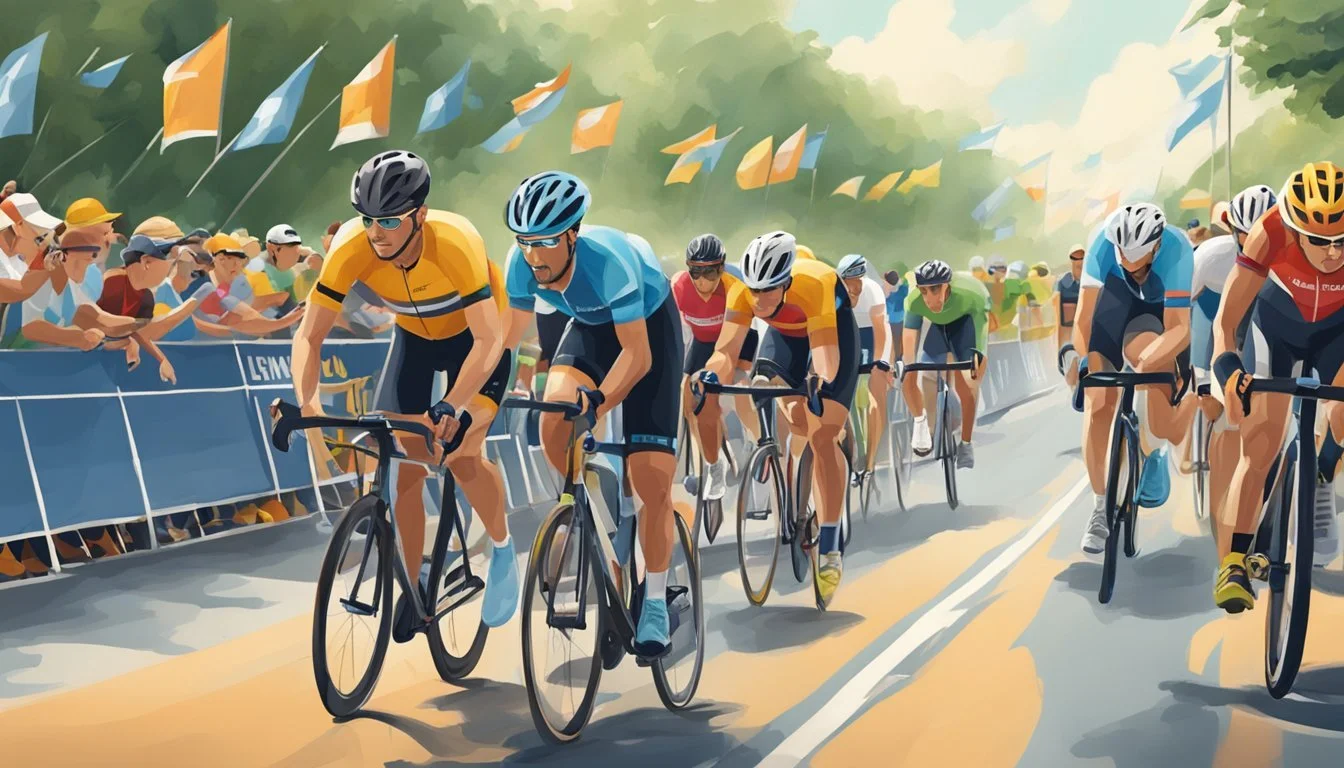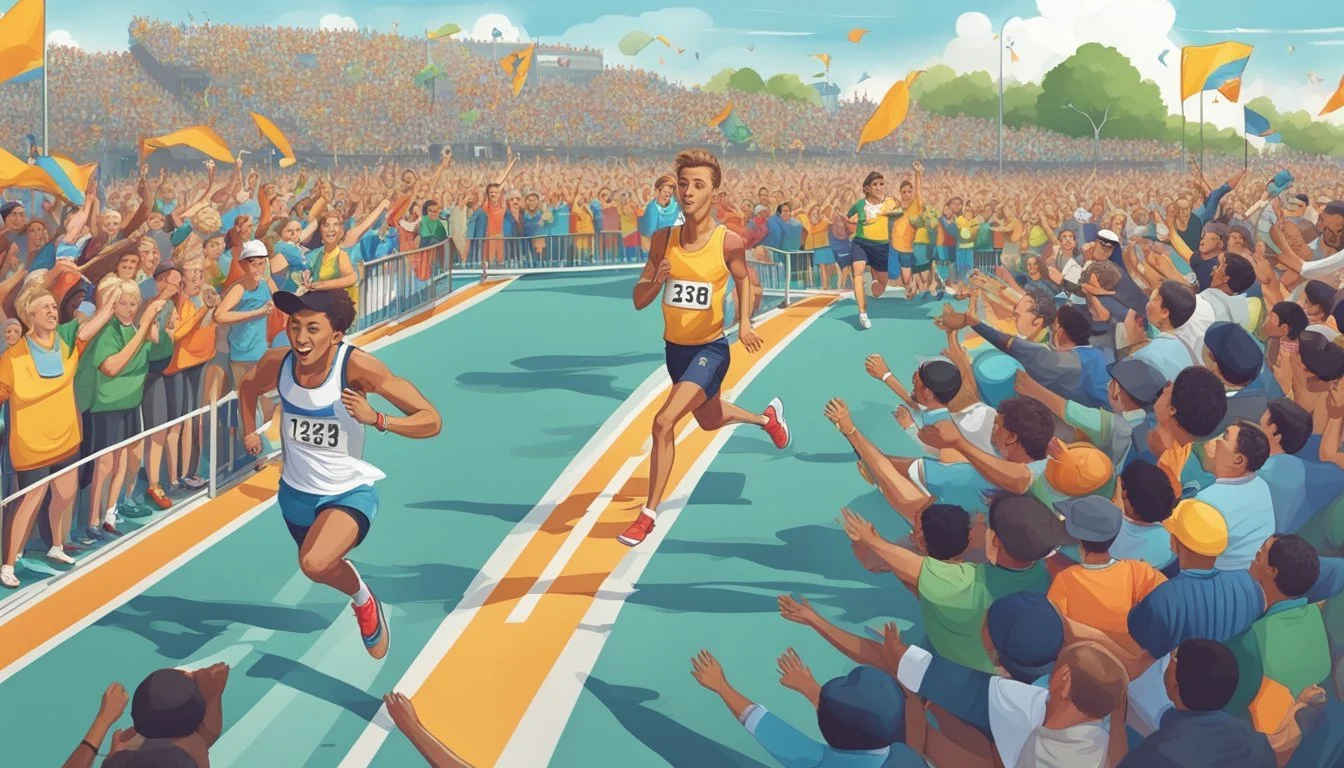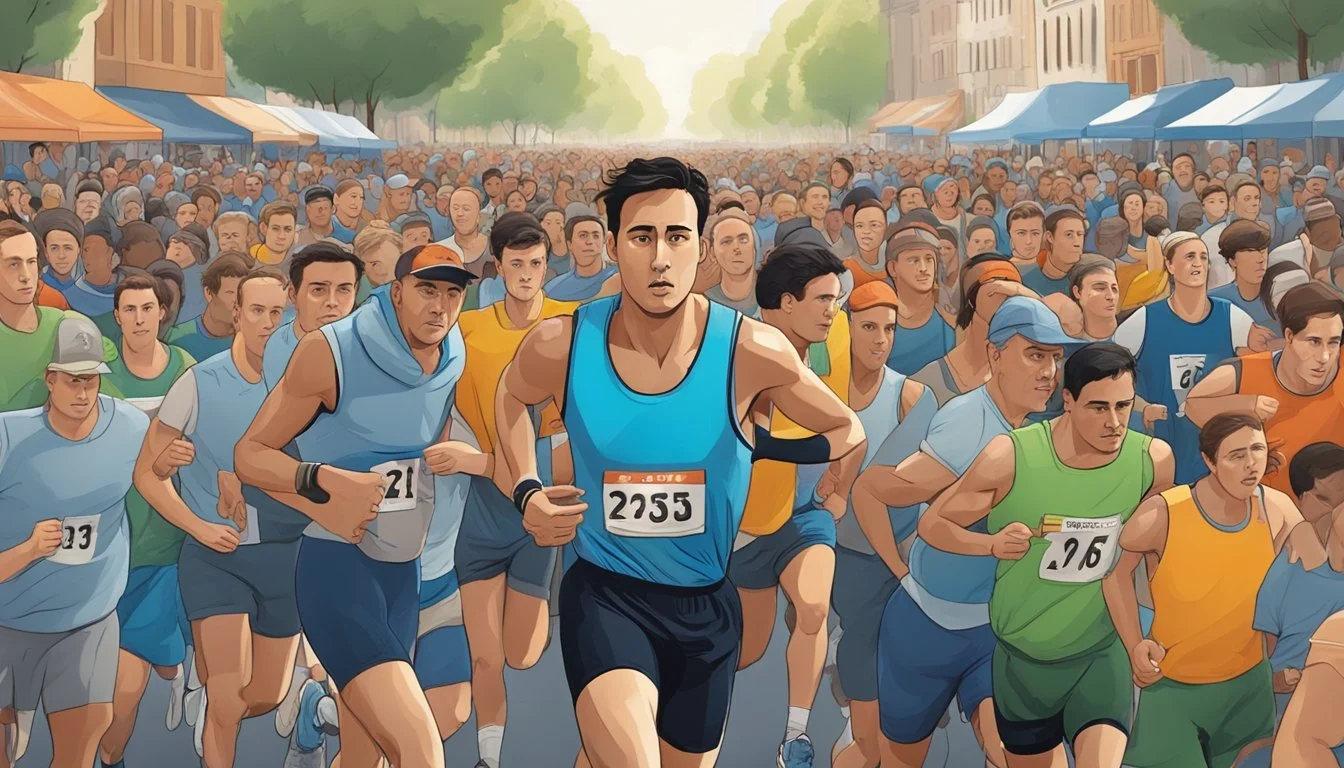Lance Armstrong Tackles New Challenge in Marathon Debut
Former Cyclist's New Endurance Challenge
Lance Armstrong, the former professional cyclist, has taken on a new challenge in recent years - marathon running. The seven-time Tour de France winner has participated in several marathons, demonstrating his enduring athletic prowess.
Armstrong's fastest marathon time to date is 2:59:36, which he achieved in his debut at the New York City Marathon in 2006. This impressive sub-3-hour performance showcased his natural talent for endurance sports, even in a discipline far removed from cycling.
More recently, Armstrong ran the Austin Marathon as a "Charity Chaser," starting 22 minutes behind other runners. His participation raised funds for various charitable causes, combining his athletic abilities with philanthropic efforts. Armstrong completed the Austin course in 3:02:14, proving he can still maintain a competitive pace over 26.2 miles.
Lance Armstrong: An Overview
Lance Armstrong's career has been marked by extraordinary achievements and devastating controversies. His journey spans professional cycling, a battle with cancer, philanthropic efforts, and a transition to marathon running.
Professional Cycling Career
Lance Armstrong dominated professional cycling for nearly a decade. He won the Tour de France, cycling's most prestigious race, an unprecedented seven consecutive times from 1999 to 2005. Armstrong's success on the bike made him a global sports icon and one of the most recognizable athletes in the world.
His aggressive riding style and seemingly superhuman endurance captivated fans and fellow competitors alike. Armstrong's influence extended beyond cycling, as he became a symbol of determination and excellence in sports.
Doping Scandal and USADA
Armstrong's cycling legacy was shattered by a doping scandal. In 2012, the United States Anti-Doping Agency (USADA) charged Armstrong with using performance-enhancing drugs throughout his career.
After years of denials, Armstrong admitted to doping in a televised interview with Oprah Winfrey in 2013. As a result, he was stripped of his seven Tour de France titles and banned from competitive cycling for life.
The scandal had far-reaching consequences, tarnishing Armstrong's reputation and leading to legal battles with sponsors and the U.S. government.
Cancer Battle and Livestrong Foundation
In 1996, Armstrong was diagnosed with testicular cancer that had spread to his brain and lungs. He underwent aggressive treatment and made a full recovery, returning to professional cycling in 1998.
Inspired by his experience, Armstrong founded the Livestrong Foundation in 1997. The organization raised millions of dollars for cancer research and support programs.
Armstrong's cancer survival story became an inspiration to many. However, the doping scandal led to his resignation from the foundation's board in 2012 to protect its reputation.
Retirement and Transition to Marathons
After retiring from professional cycling in 2005, Armstrong briefly returned to the sport in 2009 before retiring again in 2011. Following his cycling career, he turned his focus to marathon running.
Armstrong competed in several high-profile marathons, including the New York City Marathon. In his first marathon attempt in 2006, he finished in 2:59:36, just under the three-hour mark.
He described the marathon as "the hardest race of my life," highlighting the physical demands of long-distance running. Armstrong's best marathon time was 2:46:43, achieved at the 2007 New York City Marathon.
Marathons Post-Cycling
Lance Armstrong transitioned from professional cycling to marathon running after his initial retirement. He participated in several high-profile marathons in the United States, generating significant public interest and media attention.
First Events and Public Interest
Armstrong's entry into marathon running sparked curiosity among sports fans and media outlets. His first marathon appearance drew substantial attention, with many wondering how the former cyclist would fare in a different endurance sport.
The transition highlighted Armstrong's continued desire for athletic challenges. His participation in marathons also raised awareness for cancer research, a cause he had long supported.
Public interest was heightened by Armstrong's status as a cancer survivor and his previous dominance in cycling. Many spectators and fellow runners were eager to see how his endurance abilities would translate to long-distance running.
New York City Marathon Highlights
Armstrong's performance in the New York City Marathon was particularly noteworthy. He completed the race in 2:46:43, an impressive time for a marathon debut.
This achievement demonstrated Armstrong's exceptional endurance capabilities across different sports. His sub-3-hour finish placed him in the top tier of amateur runners.
Armstrong described the New York City Marathon as "the hardest race of my life." This statement underscored the intense physical demands of marathon running, even for a highly trained athlete.
The event garnered significant media coverage, further increasing public interest in Armstrong's post-cycling athletic pursuits.
Boston Marathon Participation
Armstrong also competed in the prestigious Boston Marathon. He finished the race in 2:50:58, placing 488th out of more than 25,000 participants.
This performance showcased Armstrong's consistent ability to maintain a high level of endurance across different marathon events. His participation in Boston, known for its challenging course, demonstrated his commitment to testing himself against varied running terrains.
Armstrong's presence at the Boston Marathon helped draw additional attention to the event. It also provided him with an opportunity to compete alongside a diverse field of elite and amateur runners.
Austin Marathon and Home Crowd
Armstrong's participation in the Austin Marathon held special significance as it took place in his hometown. The local crowd provided enthusiastic support for the former cycling champion.
Running in Austin allowed Armstrong to connect with his local community in a new athletic context. It also provided an opportunity for his long-time supporters to see him compete in person.
The Austin Marathon showcased Armstrong's continued commitment to endurance sports and his willingness to challenge himself in front of a home crowd. His participation helped boost the profile of the event and inspire local runners.
Training and Preparation
Lance Armstrong's transition from cycling to marathon running required a significant shift in training approach and physical preparation. His endurance sports background provided a foundation, but marathon-specific training demanded new strategies and adaptations.
Endurance Sports Shift
Armstrong's move from cycling to marathon running presented unique challenges. While both sports require exceptional cardiovascular fitness, the biomechanical demands differ greatly. Cycling primarily engages the lower body in a non-weight-bearing motion, whereas running involves full-body impact.
The former cyclist had to adapt his muscular endurance and skeletal structure to withstand the repetitive stress of running. This transition involved gradually increasing mileage and incorporating specific exercises to strengthen running-related muscles.
Armstrong's cardiovascular system, highly developed from years of cycling, gave him an advantage in aerobic capacity. However, he needed to fine-tune this fitness for the continuous impact of running.
Training Regimen for Long-Distance Running
Armstrong's marathon training focused on building running-specific endurance. He incorporated a mix of long slow distance runs, tempo runs, and interval training.
Long runs formed the cornerstone of his preparation, gradually increasing in distance to simulate race conditions. These runs helped improve his endurance and taught his body to efficiently use energy over extended periods.
Tempo runs at a "comfortably hard" pace improved his lactate threshold, allowing him to maintain faster speeds for longer durations.
Interval training sessions included:
400m repeats for speed
Mile repeats for endurance
Hill workouts for strength
Armstrong also maintained some cycling in his routine, using it as a form of cross-training to maintain fitness while reducing impact on his joints.
Nutrition and Fitness
Proper nutrition played a crucial role in Armstrong's marathon preparation. His diet focused on:
Complex carbohydrates for sustained energy
Lean proteins for muscle repair
Healthy fats for hormone balance
Adequate hydration
Armstrong's nutrition plan evolved to support the increased caloric demands of marathon training. He emphasized proper fueling before, during, and after workouts to optimize performance and recovery.
Strength training remained a key component of his fitness regimen. Exercises targeting core stability, leg strength, and upper body endurance helped improve running economy and prevent injuries.
Armstrong also incorporated flexibility work and recovery techniques such as massage and ice baths to maintain his body through the rigorous training schedule.
Collaboration with Coaches
Armstrong worked with experienced marathon coaches to develop his training plan. Notable among them was Alberto Salazar, a former world-class marathoner.
Salazar's expertise in long-distance running complemented Armstrong's athletic background. Together, they crafted a program that capitalized on Armstrong's strengths while addressing the specific demands of marathon running.
The coaching team monitored Armstrong's progress through regular fitness assessments and race simulations. They adjusted his training load and intensity based on these evaluations, ensuring optimal preparation for race day.
Armstrong's collaboration with coaches also extended to mental preparation. They worked on race strategy, pacing, and psychological techniques to maintain focus during the marathon's challenging later stages.
Charity and Awareness
Lance Armstrong's involvement in charity work and raising awareness for cancer has been significant. His efforts have spanned from founding a major cancer foundation to participating in marathon events for charitable causes.
Running for a Cause
Armstrong has used his athletic abilities to support various charities. In the 2024 Austin Marathon, he participated as a Charity Chaser. This role involved starting the race last and raising funds for every runner he passed. Armstrong completed the marathon in an impressive 3:02:13, overtaking all but 59 participants.
His performance generated substantial donations for 28 Central Texas nonprofits. The Charity Chaser program exemplifies how athletes can leverage their skills to benefit charitable organizations.
Livestrong Bracelets Impact
The Livestrong Foundation, originally founded by Armstrong in 1997, gained widespread recognition through its yellow silicone wristbands. These bracelets became a global symbol of cancer awareness and support.
Millions of people worldwide wore the Livestrong bracelets, creating a visible community of cancer supporters. The initiative raised significant funds for cancer research and support programs.
Despite controversy surrounding Armstrong, the bracelets' impact on raising cancer awareness remains noteworthy.
Charity Chaser Programs
Charity Chaser programs have become popular in marathons and other endurance events. These initiatives allow skilled athletes to raise funds while competing.
In Armstrong's case at the Austin Marathon, he started 22 minutes after the official start. This delay created excitement as he progressed through the field, with each passed runner representing additional donations.
Such programs offer a unique way to engage both participants and spectators in charitable giving. They combine athletic performance with fundraising, creating a win-win situation for charities and event organizers.
Performance and Records
Lance Armstrong's marathon performances demonstrated his athletic prowess beyond cycling. He achieved impressive times and notable finishes in several high-profile races.
Marathon Personal Bests
Armstrong's marathon personal best came at the 2007 New York City Marathon, where he finished in 2:46:43. This time placed him 214th overall out of nearly 39,000 finishers. His debut marathon time was 2:59:36 at the 2006 New York City Marathon, breaking the three-hour barrier on his first attempt.
In 2008, Armstrong improved his time at the Boston Marathon, completing the race in 2:50:58. This performance ranked him 488th out of over 25,000 participants.
Chip Time vs. Gun Time
Marathon timing systems use both chip time and gun time. Chip time measures a runner's individual performance from crossing the start line to finish line. Gun time starts when the race begins for all runners.
For elite athletes like Armstrong, chip and gun times are often nearly identical. In large marathons, chip timing provides a more accurate measure of performance for runners starting further back in the pack.
Notable Race Finishes
Armstrong's most notable marathon finish was his sub-3-hour debut in New York City. He described it as "the hardest physical thing I have ever done."
Other significant performances include:
2007 New York City Marathon: 2:46:43 (personal best)
2008 Boston Marathon: 2:50:58
2006 New York City Marathon: 2:59:36 (debut)
These results showcased Armstrong's endurance capabilities beyond cycling, earning respect in the running community despite his controversial cycling career.
Public Perception and Criticism
Lance Armstrong's involvement in marathons drew mixed reactions from the public and media. His participation reignited discussions about his past doping scandals and raised questions about his athletic abilities in a new domain.
Reactions to Marathon Involvement
Armstrong's entry into marathon running sparked curiosity and skepticism. Some fans welcomed his return to competitive sports, viewing it as a chance for redemption. Others remained critical, questioning the legitimacy of his performances given his history of performance-enhancing drug use in cycling.
Many race organizers faced ethical dilemmas about allowing Armstrong to participate. Some embraced his star power to attract attention to their events, while others declined his entry to avoid controversy.
The running community was divided. Experienced marathoners debated whether Armstrong's cycling background would translate to success in long-distance running.
Continued Doping Allegations
Despite Armstrong's efforts to move past his cycling career, doping allegations continued to follow him into marathon running. Critics speculated about whether he might be using banned substances to enhance his marathon performances.
Anti-doping agencies closely monitored Armstrong's participation in marathons. Some called for increased testing and scrutiny of his race results.
Armstrong consistently denied using performance-enhancing drugs in his marathon career. He emphasized his commitment to running clean and distancing himself from his past mistakes.
The ongoing suspicion affected public perception of his marathon achievements. Many viewed his times and placements with skepticism, regardless of his actual performance.
Reviews and Interviews
Media coverage of Armstrong's marathon career was extensive. Race reviews often focused on his finishing times and how they compared to elite runners and age-group competitors.
Post-race interviews frequently touched on his transition from cycling to running. Armstrong discussed the physical and mental challenges of adapting to a new endurance sport.
Many journalists pressed him on questions about doping in his marathon training. Armstrong's responses were carefully worded, often redirecting focus to his current efforts and charitable work.
Running magazines and websites published in-depth analyses of his training methods and race strategies. These pieces generated significant reader interest and debate in online forums.
Television appearances and podcast interviews allowed Armstrong to share his perspective on marathon running. He often emphasized the personal growth and enjoyment he found in the sport.
Impact on Endurance Sports
Lance Armstrong's involvement in marathon running and subsequent doping scandal had far-reaching effects on endurance sports. His participation brought new attention to marathons while raising questions about performance enhancement across disciplines.
Changing the Narrative
Armstrong's transition to marathons initially generated excitement and media coverage. His 2:59:36 finish in the 2006 New York City Marathon showcased the potential for elite athletes to cross over between endurance sports. However, the doping revelations altered this narrative dramatically.
The scandal prompted increased scrutiny of performance in endurance events. Marathon organizers implemented stricter drug testing protocols. Public perception shifted, with Armstrong's achievements viewed more skeptically.
This changing narrative affected how endurance sports were discussed and promoted. Event organizers and athletes faced greater pressure to demonstrate clean competition.
Influence on Athletes and Amateurs
Armstrong's marathon pursuits initially inspired many cyclists and triathletes to attempt the 26.2-mile distance. His presence at races drew new participants and media attention.
The doping scandal dampened some of this enthusiasm. It raised questions about the limits of human performance and the role of technology in endurance sports.
Some amateur athletes became more cynical about elite performances. Others redoubled their commitment to clean competition.
The controversy spurred increased interest in natural training methods and nutrition. Many endurance athletes sought ways to improve legitimately without risking their health or integrity.
Endurance Sports Features and Guides
Armstrong's marathon experiences highlighted the challenges of transitioning between endurance disciplines. This led to more features and guides on cross-training for endurance athletes.
Publications produced expert buying guides for runners transitioning from cycling. These often focused on injury prevention and proper form.
Training plans incorporating multiple endurance sports became more popular. Magazines and websites offered advice on balancing different activities for optimal performance.
The scandal also prompted more investigative features on doping in amateur ranks. Guides on spotting signs of performance-enhancing drug use became common in endurance sports media.
Conclusion
Lance Armstrong's foray into marathon running demonstrates his exceptional athletic abilities beyond cycling. His sub-3-hour finish in the New York City Marathon showcased his endurance and determination.
Armstrong's marathon performances have left a lasting impact on endurance sports. His transition from cycling to long-distance running inspired other athletes to explore diverse athletic challenges.
The former cyclist's marathon achievements contribute to his complex legacy. While controversy surrounds his cycling career, his running accomplishments stand as a testament to his athletic prowess.
Armstrong's marathon experiences highlight the intense physical and mental demands of long-distance running. His description of the New York City Marathon as "the hardest race of my life" underscores the unique challenges of this discipline.
Future endurance athletes may draw inspiration from Armstrong's ability to excel in multiple sports. His success in marathons demonstrates the potential for cross-disciplinary athletic achievement at the highest levels.






